
European Physical Journal-Special Topics
Scope & Guideline
Navigating the Nexus of Physics and Materials Innovation
Introduction
Aims and Scopes
- Interdisciplinary Research:
EPJ-ST encourages contributions that integrate concepts and techniques from various branches of physics, including condensed matter, quantum mechanics, and statistical physics, fostering collaboration and innovation. - Advanced Computational Techniques:
The journal frequently publishes studies utilizing advanced computational methods, including machine learning, numerical simulations, and complex modeling approaches, to address contemporary challenges in physics. - Applied Physics and Engineering:
Research that applies physical principles to technological advancements, such as energy harvesting, nanotechnology, and biomedical applications, is a significant focus, highlighting the practical implications of physics research. - Theoretical Developments:
EPJ-ST features contributions that advance theoretical frameworks in physics, particularly those that explore novel phenomena, chaotic systems, and non-equilibrium dynamics. - Experimental Physics:
The journal also emphasizes experimental studies that provide empirical evidence for theoretical predictions, particularly in high-energy physics and material science.
Trending and Emerging
- Machine Learning Applications:
The integration of machine learning techniques in various physics domains, such as high-energy physics and material science, is rapidly gaining traction, with studies focusing on predictive modeling and data analysis. - Quantum Technologies:
Research on quantum computing, quantum information, and quantum materials is on the rise, driven by advancements in experimental techniques and theoretical frameworks. - Complex Systems and Network Dynamics:
There is an increasing interest in the study of complex systems, including biological and ecological networks, highlighting the interconnectedness of systems and their emergent behaviors. - Nanotechnology and Advanced Materials:
Investigations into nanomaterials and their applications in energy, electronics, and biomedical fields are trending, reflecting a shift towards innovative materials science. - Multiscale Modeling:
The trend towards multiscale modeling approaches that bridge different physical scales—from atomic to macroscopic—is becoming prominent, addressing complex physical phenomena in a holistic manner.
Declining or Waning
- Classical Mechanics:
Research focusing solely on classical mechanics has decreased, as the field becomes increasingly integrated with modern physics concepts and computational techniques. - Traditional Solid-State Physics:
Studies that explore conventional solid-state physics phenomena without incorporating advanced materials or nanotechnology are less frequently published, reflecting a pivot towards more innovative approaches. - Non-quantum Statistical Mechanics:
There has been a noticeable decline in publications centered around traditional statistical mechanics frameworks, as researchers explore more complex systems that require non-standard approaches. - Isolated Phenomena Studies:
Research that examines isolated phenomena without considering broader interdisciplinary implications has waned, as the trend moves towards interconnected systems and their collective behaviors. - Low-Impact Experimental Studies:
Experimental work that lacks robust theoretical backing or fails to address significant scientific questions is becoming less common, as the field demands higher relevance and impact.
Similar Journals
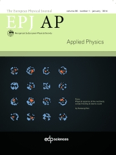
EUROPEAN PHYSICAL JOURNAL-APPLIED PHYSICS
Transforming Ideas into Impactful ResearchEUROPEAN PHYSICAL JOURNAL-APPLIED PHYSICS, published by EDP SCIENCES S A in France, serves as a vital platform for the dissemination of cutting-edge research in the fields of condensed matter physics, electronic, optical and magnetic materials, and instrumentation. With an ISSN of 1286-0042 and E-ISSN of 1286-0050, this journal has been a valuable resource for researchers since its inception in 1998, aiming to foster innovation and dialogue among professionals and academics alike. Featuring an impact factor that reflects its growing influence, the journal is currently ranked in the Q4 quartile for several related categories in 2023, underscoring its ongoing contributions to the scientific community despite its relatively competitive positioning. Access to the journal is available through various Open Access options, ensuring that pioneering research is readily accessible to all. As it continues to evolve towards its 2024 objectives, EUROPEAN PHYSICAL JOURNAL-APPLIED PHYSICS remains dedicated to advancing knowledge and facilitating collaboration in applied physics, making it an essential resource for students, researchers, and professionals dedicated to exploring the forefront of physical sciences.

Nuovo Cimento C-Colloquia and Communications in Physics
Bridging Ideas in Astronomy and PhysicsNuovo Cimento C-Colloquia and Communications in Physics is a distinguished peer-reviewed journal published by the SOC ITALIANA FISICA, dedicated to the dissemination of novel research and communications in the vibrant fields of Astronomy and Physics. Established in 1978, this journal provides a platform for scientists and researchers to present their findings, fostering academic dialogue and collaboration within the community. As of 2023, the journal holds a Q4 quartile ranking in both Astronomy and Astrophysics and Physics and Astronomy (miscellaneous), reflecting its commitment to contributing to the scientific corpus despite its emerging status in the competitive landscape. Based in Italy, the journal is accessible to a global audience, enhancing its reach and influence. Although currently not an open access journal, it remains an essential resource for researchers and professionals seeking to stay informed on cutting-edge developments in physics and astronomy. Its ongoing convergence of knowledge from 1978 to 2024 promises to enrich the scholarly discourse and advance the frontiers of research in these dynamic fields.

Ukrainian Journal of Physics
Advancing Physics Through Open DialogueUkrainian Journal of Physics, published by the Bogolyubov Institute for Theoretical Physics of the National Academy of Sciences of Ukraine, stands as a significant platform for the dissemination of research in the dynamic field of physics. With its ISSN 2071-0186 and E-ISSN 2071-0194, the journal aims to foster academic dialogue and innovation among researchers, professionals, and students alike. Recognized with a Scopus ranking that places it in the 26th percentile, the journal offers an array of contributions spanning various domains, including general physics and astronomy. Although currently categorized in the Q3 quartile for 2023, it seeks to elevate its scholarly impact while providing open access to its contents, facilitating wider availability and engagement. With a commitment to publishing high-quality research from 2007 to 2024, the journal embraces interdisciplinary approaches to physics, making it an invaluable resource for anyone dedicated to advancing their understanding and exploration of physical sciences.
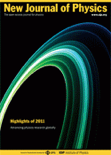
NEW JOURNAL OF PHYSICS
Bridging theory and practice in contemporary physics.NEW JOURNAL OF PHYSICS, published by IOP Publishing Ltd, is a prestigious open-access journal that has been at the forefront of the physics community since its inception in 1998. With an impact factor that places it in the Q1 category of Physics and Astronomy (miscellaneous) and a commendable ranking of #49 out of 243 in the general physics and astronomy category according to Scopus, this journal is recognized for its significant contribution to advancing research in the field. The journal caters to a broad scope of topics, providing a platform for the dissemination of cutting-edge research findings and innovative theoretical explorations. Operating from the United Kingdom, it offers a truly international perspective, making its contents accessible and impactful to a global audience. With robust open-access options, the NEW JOURNAL OF PHYSICS ensures that research findings are freely available, promoting collaboration and knowledge sharing among researchers, professionals, and students alike. This commitment to accessibility, combined with its high-quality content, makes it an essential resource for anyone engaged in the physics community.

JETP LETTERS
Fostering Breakthroughs in Theoretical and Experimental ScienceJETP LETTERS, published by MAIK NAUKA/INTERPERIODICA/SPRINGER, is a prestigious journal in the field of physics and astronomy, which plays a pivotal role in disseminating groundbreaking research and innovative ideas since its inception in 1969. With an ISSN of 0021-3640 and an E-ISSN of 1090-6487, this journal aligns well with the interests of both seasoned researchers and emerging scholars, having achieved a 2023 category rank of Q3 for miscellaneous topics within physics and astronomy. Located in the United States at 233 SPRING ST, NEW YORK, NY 10013-1578, JETP LETTERS serves as a critical resource for its readership, offering exclusive insights and advancements across diverse areas of physics. While not open access, it hosts a collection of articles that refine theoretical approaches and experimental methods, providing both knowledge and inspiration to professionals and academics seeking to make impactful contributions to the scientific community. The journal’s quality is reflected in its Scopus ranking, where it stands at 39 out of 81 in the multidisciplinary category, placing it in the 52nd percentile, thus underscoring its significance and reliability as a scholarly outlet.
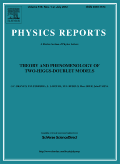
PHYSICS REPORTS-REVIEW SECTION OF PHYSICS LETTERS
Fostering a deeper understanding of the universe.Physics Reports - Review Section of Physics Letters is a prestigious journal published by Elsevier, dedicated to providing comprehensive and insightful reviews in the field of physics and astronomy. With its ISSN 0370-1573 and E-ISSN 1873-6270, this esteemed publication features high-quality content that spans a converged timeline from 1971 to 2024. Recognized as a Q1 journal in the Physics and Astronomy category for 2023, it holds a remarkable Scopus ranking of #2 out of 243, placing it firmly in the top 1% of its field. The journal serves as a pivotal resource for researchers, professionals, and students alike, facilitating the dissemination of critical analyses and contemporary developments in physics. While it is not open access, its rigorous peer-reviewed articles ensure that students and researchers remain at the forefront of scientific inquiry. With its impactful contributions, Physics Reports continues to enhance the knowledge base and push forward the boundaries of physics research.

JOURNAL OF STATISTICAL PHYSICS
Advancing the frontiers of Statistical and Nonlinear Physics.The Journal of Statistical Physics, published by Springer, is a premier academic journal that has made significant contributions to the fields of Mathematical Physics and Statistical and Nonlinear Physics since its inception in 1969. With a strong reputation reflected in its 2023 rankings—placing it in Q2 of both categories and achieving an impressive Scopus rank of #22 in Mathematical Physics and #25 in Statistical and Nonlinear Physics—this journal serves as a vital platform for researchers, professionals, and students. The impact factor of the journal underscores its importance in disseminating cutting-edge research and theoretical developments. Authors are invited to submit original research articles that explore the intricate complexities of statistical mechanics, quantum physics, and related disciplines, fostering deep insights and academic discourse. Although the journal does not currently offer open access, its robust editorial standards and commitment to advancing knowledge make it an essential resource for those engaged in these dynamic fields.
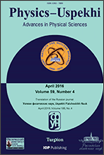
PHYSICS-USPEKHI
Advancing Knowledge in Theoretical and Experimental PhysicsPHYSICS-USPEKHI, published by Uspekhi Fizicheskikh Nauk, is a prominent peer-reviewed journal in the field of physics and astronomy, reaching researchers and professionals since its inception in 1993. With an ISSN of 1063-7869 and an E-ISSN of 1468-4780, this esteemed journal has been classified as Q2 in the Physics and Astronomy category based on the 2023 quartiles, ranking 74 out of 243 journals in its Scopus classification, placing it in the 69th percentile. Although currently not an open access journal, it provides invaluable insights and advancements in the field, fostering an environment for scholarly exchange and collaborative research. Based in Moscow, Russia, PHYSICS-USPEKHI continues to shape the landscape of theoretical and experimental physics, inviting submissions that contribute to its rich legacy of high-impact scientific discourse.

ACTA PHYSICA SINICA
Bridging Ideas in Physics for a Brighter FutureACTA PHYSICA SINICA is a prominent journal published by the Chinese Physical Society, dedicated to the dissemination of groundbreaking research in the field of physics and astronomy. Established in 1993, this journal has consistently contributed to the scientific community by publishing high-quality articles that cover a wide range of topics within general physics and related disciplines. Although currently classified in Q4 of the physics and astronomy category by Scopus, ACTA PHYSICA SINICA plays an important role in fostering collaboration and communication among researchers in China and around the world. With a substantial readership, this journal is poised to remain a valuable resource for professionals, researchers, and students alike. By providing in-depth analysis and insights, it aims to advance the understanding and application of physical principles in various technological and scientific advancements. The journal is accessible via subscription, ensuring that contributors and readers can engage with the evolving landscape of physics research. For more information, visit the publisher's website.
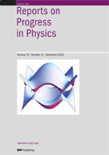
REPORTS ON PROGRESS IN PHYSICS
Elevating knowledge through comprehensive physics insights.Reports on Progress in Physics is a prestigious scholarly journal published by IOP Publishing Ltd, based in the United Kingdom. With an illustrious history dating back to 1934, this journal serves as a vital resource for researchers and professionals in the fields of physics and astronomy, offering comprehensive overviews of significant developments in these disciplines. It holds a commendable Q1 classification in both Medicine (miscellaneous) and Physics and Astronomy (miscellaneous) categories, further underscored by its impressive ranking as 4th out of 243 in the general physics and astronomy sector, placing it in the top 2% percentile on Scopus. The journal is dedicated to disseminating high-quality, peer-reviewed articles that facilitate the understanding of complex physical phenomena and their applications. Although it does not currently offer open access options, its rigorous editorial standards ensure that only the most impactful research reaches its wide audience of academics, practitioners, and students, solidifying its role as a cornerstone of knowledge in the physical sciences.